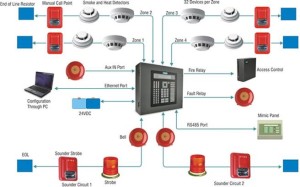Products

Get your Hiphen Solutions Fire Alarm System,The company’s specialists carry out the designing, assembling and installation of automatic fire alarm at the entities of any complexity in all regions of india. We can also provide comprehensive protection-fire alarm systems, including access control, warning and evacuation management, video monitoring, radio monitoring and maintenance.
Specialists of Hiphen Solutions Security Systems will help you choose the high quality fire-fighting equipment from india and abroad, and, on the customer’s request, organize the delivery of equipment in the contract time. Hiphen Solutions arranges all necessary documentation in the public fire service, saving you money and time and sparing you from bureaucratic red tape.

Fire alarm system designed to detect early signs of fire in the protected premises and to generate the signal to control the fire protection systems ( alarm, smoke removal, fire fighting etc.), as well as other equipment (elevators, pumps, fans, etc.)
Start of combustion can be determined by:
- Sharp increase of temperature inside the protected premises.
- Formation of products of combustion (smoke).
- Open flames.
That is why there is a number of different sensors (heat, smoke, aspiration, flame) reacting to a particular trait. In addition to the various sensors used in automatic fire alarm installations, these systems can be addressed and addressless. Therefore, when choosing the optimal solution for the protection of the object one has take into account its purpose, presence and type of combustible materials, plan peculiarities, as well as the ability to manage other engineering systems.
Specialists of Hiphen Solutions Security Systems will help you make the right choice of automatic fire alarm system to ensure maximum safety and save your money.
Automatic fire alarm systems can be used to notify people to evacuate in the event of a fire or other emergency, to summon emergency services, and to prepare the structure and associated systems to control the spread of fire and smoke.
After the fire protection goals are established – usually by referencing the minimum levels of protection mandated by the appropriate model building code, insurance agencies, and other authorities – the fire alarm designer undertakes to detail specific components, arrangements, and interfaces necessary to accomplish these goals.
Equipment specifically manufactured for these purposes are selected and standardized installation methods are anticipated during the design.
WIRELESS SMOKE/FIRE ALARM SYSTEM
Adapting measures against the threat of smoke and fire has become very essential in every industry.
With growing concerns over the safety measures, smoke and fire detection systems in Nigeria can be one of the most effective installation.
Our wireless fire alarm systems are ideal solution for difficult to wire locations,
room aesthetics or even hazardous materials, such as asbestos above a drop ceiling.
Installation of these wireless security system provides a very cost effective solutions with features which are even not possible in wired systems.
Our wireless smoke alarms and wireless smoke detectors can be programmed in any zone between 1 to 999 nos.
The power radio emitter attached with it gets activated by presence of smoke and then it sends radio waves to the panel.
The panel automatically displays the same zone in which it has been programmed. If required, the programmed zones can be changed to another zone.
There is also a inbuilt hooter in the detectors as well as radio emitter that functions with call button ( manual call point ).
WE CAN INSTALL IN ANYWHERE IN NIGERIA
Fundamental Configuration
- Fire alarm control panel: This component, the hub of the system, monitors inputs and system integrity, controls outputs and relays information.
- Primary Power supply: Commonly the non-switched 120 or 240 Volt Alternating Current source supplied from a commercial power utility. In non-residential applications, a branch circuit is dedicated to the fire alarm system and its constituents. “Dedicated branch circuits” should not be confused with “Individual branch circuits” which supply energy to a single appliance.
- Secondary (backup) Power supplies: This component, commonly consisting of sealed lead-acid storage batteries or other emergency sources including generators, is used to supply energy in the event of a primary power failure.
- Initiating Devices: This component acts as an input to the fire alarm control unit and are either manually or automatically actuated. Examples would be devices like pull stations or smoke detectors.
- Notification appliances: This component uses energy supplied from the fire alarm system or other stored energy source, to inform the proximate persons of the need to take action, usually to evacuate. This is done by means of a flashing light, strobe light, electromechanical horn, speaker, or a combination of these devices.
- Building Safety Interfaces: This interface allows the fire alarm system to control aspects of the built environment and to prepare the building for fire and to control the spread of smoke fumes and fire by influencing air movement, lighting, process control, human transport and exit.
Initiating devices
- Manually actuated devices; Break glass stations, Buttons and manual pull station are constructed to be readily located (near the exits), identified, and operated.
- Automatically actuated devices can take many forms intended to respond to any number of detectable physical changes associated with fire: convected thermal energy; heat detector, products of combustion; smoke detector, radiant energy; flame detector, combustion gasses; carbon monoxide detector and release of extinguishing agents; water-flow detector.
- The newest innovations can use cameras and computer algorithms to analyze the visible effects of fire and movement in applications inappropriate for or hostile to other detection methods.
Notification appliances
- Audible, visible, tactile, textual or even olfactory stimuli (odorizer) to alert the occupants. Audible or visible signals are the most common and may utilize speakers to deliver live or pre-recorded instructions to the occupants. In the United States, fire alarm evacuation signals are required to use a standardized interrupted four count temporal pattern to avoid confusion with other signals using similar sounding appliances. Other methods include:
- Audible textual appliances, which are employed as part of a fire alarm system that includes Emergency Voice Alarm Communications (EVAC) capabilities. High reliability speakers are used to notify the occupants of the need for action in connection with a fire or other emergency. These speakers are employed in large facilities where general undirected evacuation is considered impracticable or undesirable.
- The signals from the speakers are used to direct the occupant’s response. The system may be controlled from one or more locations within the building known as Fire Wardens Stations, or from a single location designated as the building Fire Command Center. Speakers are automatically actuated by the fire alarm system in a fire event, and following a pre-alert tone, selected groups of speakers may transmit one or more prerecorded messages directing the occupants to safety.
- These messages may be repeated in one or more languages. Trained personnel activating and speaking into a dedicated microphone can suppress the replay of automated messages in order to initiate or relay real time voice instructions.
Building safety interfaces
- Magnetic Smoke Door Holders: Wall or floor mounted solenoids or electromagnets controlled by a fire alarm system or detection component that magnetically secures spring-loaded self-closing smoke tight doors in the open position.
- Designed to de-magnetize to allow automatic closure of the door on command from the fire control or upon failure of the power source, interconnection or controlling element. Stored energy in the form of a spring or gravity can then close the door to restrict the passage of smoke from one space to another in an effort to maintain a tenable atmosphere on either side of the door during evacuation and fire fighting efforts.
- Duct Mounted Smoke Detection: Smoke detection mounted in such a manner as to sample the airflow through duct work and other plenums specifically fabricated for the transport of environmental air into conditioned spaces. Interconnection to the fan motor control circuits are intended to stop air movement, close dampers and generally prevent the recirculation of toxic smoke and fumes produced by fire into occupiable spaces.
-
Initiating devices
- Manually actuated devices; Break glass stations, Buttons and manual pull station are constructed to be readily located (near the exits), identified, and operated.
- Automatically actuated devices can take many forms intended to respond to any number of detectable physical changes associated with fire: convected thermal energy; heat detector, products of combustion; smoke detector, radiant energy; flame detector, combustion gasses; carbon monoxide detector and release of extinguishing agents; water-flow detector.
- The newest innovations can use cameras and computer algorithms to analyze the visible effects of fire and movement in applications inappropriate for or hostile to other detection methods.
Notification appliances
- Audible, visible, tactile, textual or even olfactory stimuli (odorizer) to alert the occupants. Audible or visible signals are the most common and may utilize speakers to deliver live or pre-recorded instructions to the occupants. In the United States, fire alarm evacuation signals are required to use a standardized interrupted four count temporal pattern to avoid confusion with other signals using similar sounding appliances. Other methods include:
- Audible textual appliances, which are employed as part of a fire alarm system that includes Emergency Voice Alarm Communications (EVAC) capabilities. High reliability speakers are used to notify the occupants of the need for action in connection with a fire or other emergency. These speakers are employed in large facilities where general undirected evacuation is considered impracticable or undesirable.
- The signals from the speakers are used to direct the occupant’s response. The system may be controlled from one or more locations within the building known as Fire Wardens Stations, or from a single location designated as the building Fire Command Center. Speakers are automatically actuated by the fire alarm system in a fire event, and following a pre-alert tone, selected groups of speakers may transmit one or more prerecorded messages directing the occupants to safety.
- These messages may be repeated in one or more languages. Trained personnel activating and speaking into a dedicated microphone can suppress the replay of automated messages in order to initiate or relay real time voice instructions.
Building safety interfaces
- Magnetic Smoke Door Holders: Wall or floor mounted solenoids or electromagnets controlled by a fire alarm system or detection component that magnetically secures spring-loaded self-closing smoke tight doors in the open position.
- Designed to de-magnetize to allow automatic closure of the door on command from the fire control or upon failure of the power source, interconnection or controlling element. Stored energy in the form of a spring or gravity can then close the door to restrict the passage of smoke from one space to another in an effort to maintain a tenable atmosphere on either side of the door during evacuation and fire fighting efforts.
- Duct Mounted Smoke Detection: Smoke detection mounted in such a manner as to sample the airflow through duct work and other plenums specifically fabricated for the transport of environmental air into conditioned spaces. Interconnection to the fan motor control circuits are intended to stop air movement, close dampers and generally prevent the recirculation of toxic smoke and fumes produced by fire into occupiable spaces.




